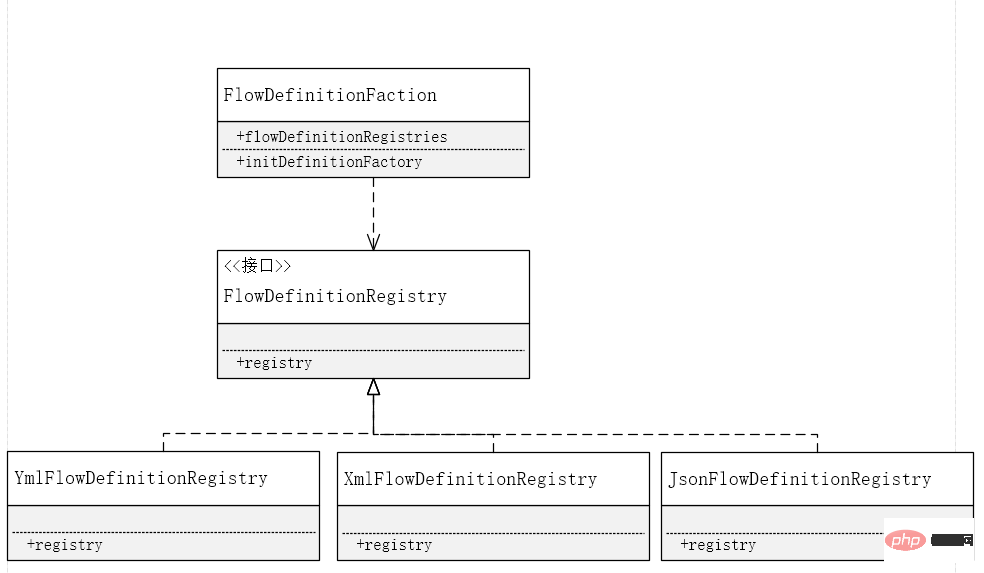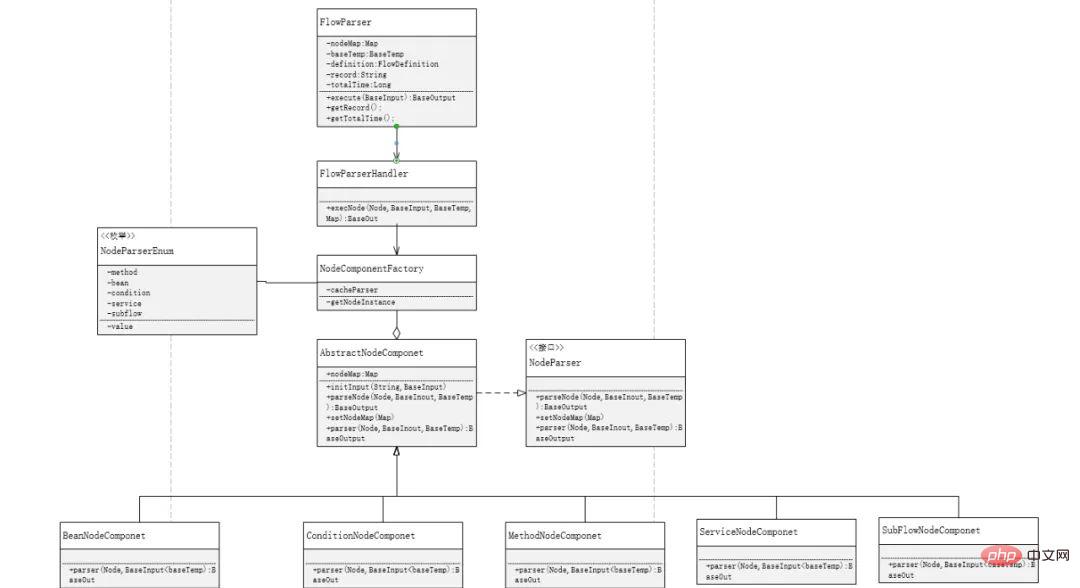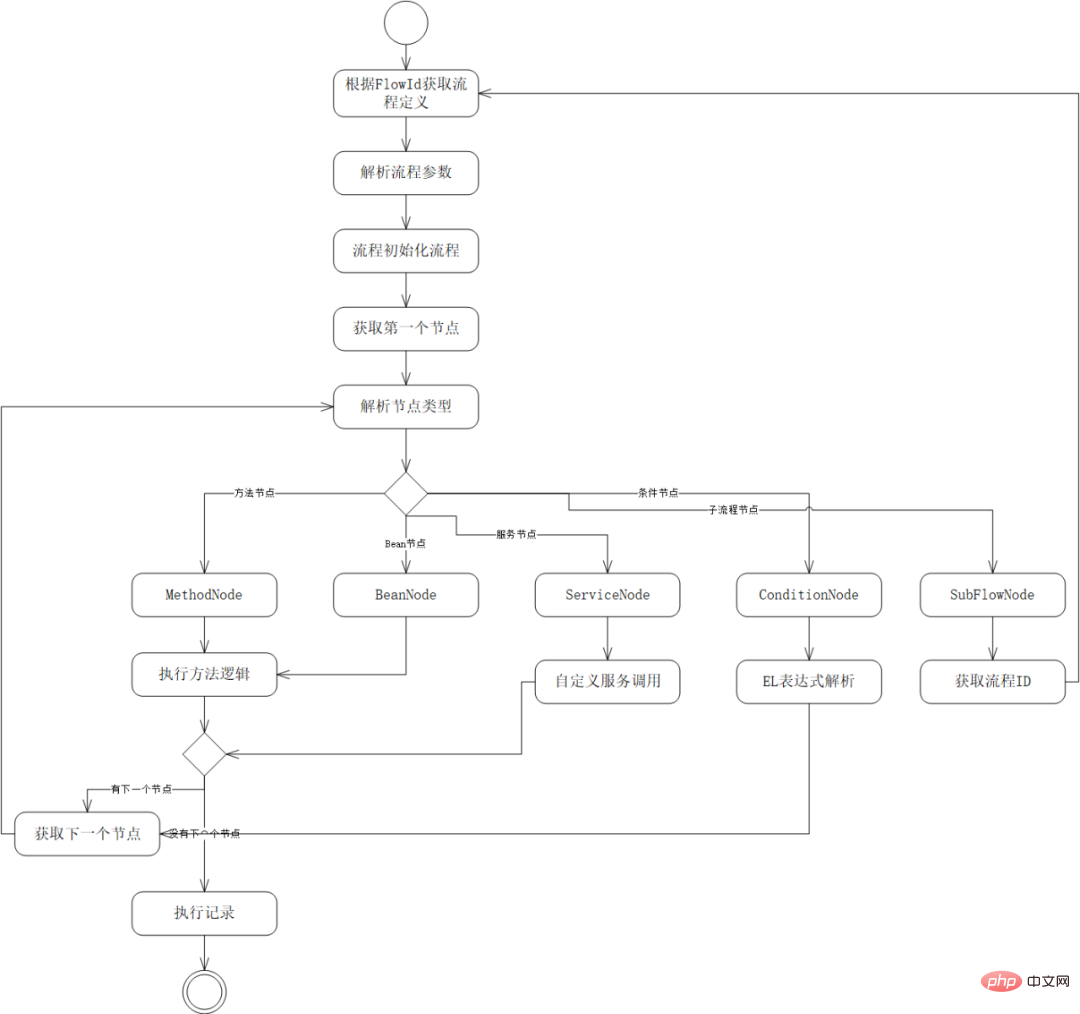
I mentioned before that we need to support the registration of process models in the form of yml, properties, xml, json, and interfaces. In order to reflect the Single Responsibility Principle, we need to use a format The parsing logic is processed independently. In order to reflect the principle of expansion development and modification closure , we first define a set of interfaces and then provide the corresponding implementation logic through the factory model; here the factory is Users call specific implementations through interfaces. The implementation here is the provider, which is also a set of strategy patterns.

Process Loading We need to know several other required function points: 1. Provide a unified external access interface; 2. Provide Execution records and execution time-consuming; 3. Different process nodes need to define different parsers; 4. Create parsing types through factories; 5. Process nodes are executed in order.

Perform different parsing methods through different node types. It is obvious that we need to use factory mode to create parsing classes, and we need to External expansion development is closed for modification. When adding nodes, you do not need to touch other code logic. You only need to add a node parser in the factory function; at the same time, we define a Map collection here to use the parsing object when loading the factory function. Create, instead of creating a parser every time you parse, to reduce unnecessary memory
The code is as follows:
<code>public class NodeComponentFactory {<br><br> private final static Map<string> cacheParser = new HashMap();<br><br> static {<br> cacheParser.put(NodeParserEnum.method.name(),new MethodNodeComponent());<br> cacheParser.put(NodeParserEnum.bean.name(),new BeanNodeComponent());<br> cacheParser.put(NodeParserEnum.condition.name(),new ConditionNodeComponent());<br> cacheParser.put(NodeParserEnum.service.name(),new ServiceNodeComponent());<br> cacheParser.put(NodeParserEnum.subflow.name(),new SubFlowNodeComponent());<br> }<br><br> public static NodeParser getNodeInstance(String nodeName){<br> return cacheParser.get(nodeName);<br> }<br>}<br></string></code>When we find that each node parsing type needs to implement parser interface, and each node has similar steps, then we must consider using an abstract factory here, which also conforms to the design principle of Dependency Inversion. The upper module is accessed through the dependency interface, and the next module inherits the abstraction class, and also used Strategy Pattern to make interface calls; in the logical process of implementation, we will find that many steps are repeated, such as initializing parameters and executing records, so we put the repeated content into abstract classes , through template mode, the process node only focuses on the parsing level;
<code>public abstract class AbstractNodeComponent implements NodeParser{<br><br> public Map<string node> nodeMap;<br><br><br> /**<br> * 初始化参数<br> * @param inputUrl<br> * @param baseInput<br> * @return<br> */<br> public BaseInput initInput(String inputUrl, BaseInput baseInput){<br> BaseInput baseInputTarget = ClassUtil.newInstance(inputUrl, BaseInput.class);<br> BeanUtils.copyProperties(baseInput,baseInputTarget);<br> return baseInputTarget;<br> }<br><br><br> /**<br> * 解析节点信息<br> * @param node 节点信息<br> * @param baseInput 请求参数<br> * @param baseTemp 临时上下文<br> * @return<br> */<br> public BaseOutput parserNode(Node node, BaseInput baseInput, BaseTemp baseTemp){<br> baseTemp.setFlowRecord(baseTemp.getFlowRecord().append(FlowConstants.NODEKEY+FlowConstants.NODE+FlowConstants.COLON+node.getId()));<br> BaseOutput baseOutput = parser(node, baseInput, baseTemp);<br> return baseOutput;<br> };<br><br> @Override<br> public void setNodeMap(Map<string node> nodeMap) {<br> this.nodeMap = nodeMap;<br> }<br><br> @Override<br> public abstract BaseOutput parser(Node node, BaseInput baseInput, BaseTemp baseTemp);<br><br>}</string></string></code>For process execution, we need to divide the components very finely, preferably A class that independently implements a function is divided into a component, embodying the single responsibility principle. Only by dividing the execution functions very finely can they be flexibly combined in each process of process execution; in the flow chart below, you can Seeing several components, the first one is the entrance for unified execution of the process. It will be used in two places. The first is the interface for external calls, and the second is the entrance for sub-process execution; the second component It is the node that loads the management component uniformly, which is the factory class mentioned above; the third is each component's own parser, which is used to implement the operation of different types of nodes; in the design process, you must know the relationship between process, management, and nodes. The boundaries between components reduce coupling, so that different components can be flexibly composed.

The above is the detailed content of How to implement a process orchestration framework in java. For more information, please follow other related articles on the PHP Chinese website!




